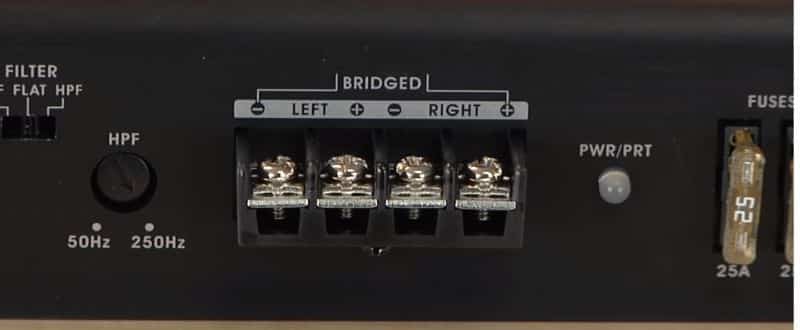A common query among the new generation of car audiophiles is how they can bridge two channels of their car amp. I will not only be answering that question but also be giving step-by-step instructions on how to bridge a 2-channel amp.
Briefly speaking, you can take any bridgeable 2 channel amp for the action. You only need to connect the left positive to the sub’s positive terminal and right negative to the sub’s negative terminal. But, while proceeding you will have to keep some key aspects in mind. Read the next section to get a detailed overview of the bridging process, which includes only 4 steps.
In This Article
Step-by-Step Guide to Bridging a 2-Channel Amp
It is an easy process, and after reading the following steps, you will be nailing the process without any confusion.
Step 1: Know If Your Amp Can Handle Bridging
Before you get started, check the amp's manual to know if your amp and speakers can handle bridging.
Once you've confirmed that your amp can be bridged, gather the necessary tools and equipment, including speaker wires, wire strippers, and possibly screwdrivers.
Before taking the next step, disconnect the negative terminal of your car battery. It is vital to prevent any electrical mishaps.
Step 2: Be Aware of Your Speaker’s Impedance
When bridging an amplifier, the impedance (measured in ohms) of the speakers becomes a critical factor. In a bridged mode, the amplifier sees half the actual impedance of the connected speaker.
For instance, if you bridge an amplifier and connect a 4-ohm speaker, the amp will perceive it as 2 ohms. It’s essential to ensure that the speaker's impedance is within the range that the amp can handle when bridged. Failure to do so can result in overheating and damage to the amplifier.
Step 3: Connect to the Subwoofer
First, you will have to locate the bridging supported channels on your amplifier. These are often clearly marked and detailed in the amp's manual. Typically, you will be using the positive (+) terminal of one channel and the negative (-) terminal of the other.
The terminals may be labeled for easy identification. Depending on what amp you have, you may notice the Left Channel ("A" for the positive terminal, "B" for the negative terminal) and the Right Channel ("C" for the positive terminal, "D" for the negative terminal)
By bridging a 2-channel amp, you will be converting two separate channels into a single unit.
Therefore, you will have to take the wires from your subwoofer and make the following connections:

- Attach the positive lead of the subwoofer to the Left channel's positive or "A" terminal.
- Attach the negative lead of the subwoofer to the Right channel's negative or "D" terminal.
For each connection, unscrew the terminal screw, place the wire between the top and bottom parts of the terminal, and then screw it down tightly to ensure a secure and stable connection.
Step 4: Adjust Your Amplifier’s Settings
After connecting the sub, you will need to adjust the amplifier's settings. If your amplifier has a switch to toggle between stereo and bridged modes, set it to bridged. You might need to adjust the gain and other controls, such as the crossover frequency, especially if you're using the bridged amp to drive a subwoofer. It's essential to start with a low gain setting and gradually increase it to avoid damaging the speaker.
If you want to know more about how to adjust your amp settings you can read my Best Amp Settings for Bass Article.
After reconnecting the batteries to your automobile, test the newly bridged system. Turn the volume up slightly at first to ensure everything works as it should.
Can You Bridge a 2-Channel Amp to 2 Subs?
When using two subs, you are not exactly bridging in the traditional sense but rather using each channel to power one subwoofer. The key is ensuring that the amp can handle the combined load.
After bridging the power of 2 channels, you will have a newly configured amp that will act like a mono-amp. You can connect your subs to that, via parallel or series connection using traditional methods. You can learn more about those methods in Can You Hook up 2 Subs to a Mono Amp?
Closing Remarks
Bridging a two-channel amplifier in your vehicle is similar to discovering a new audio system. It doubles your amplifier's power, giving your speaker new dynamics of richness and depth.
Understanding how to bridge a 2-channels amp is the basis for bridging any configuration. But, if you still get confused about higher channel bridging, I have got you covered. Read our articles 4-channel Bridging and 5-channel Bridging to know more.
See Also:

